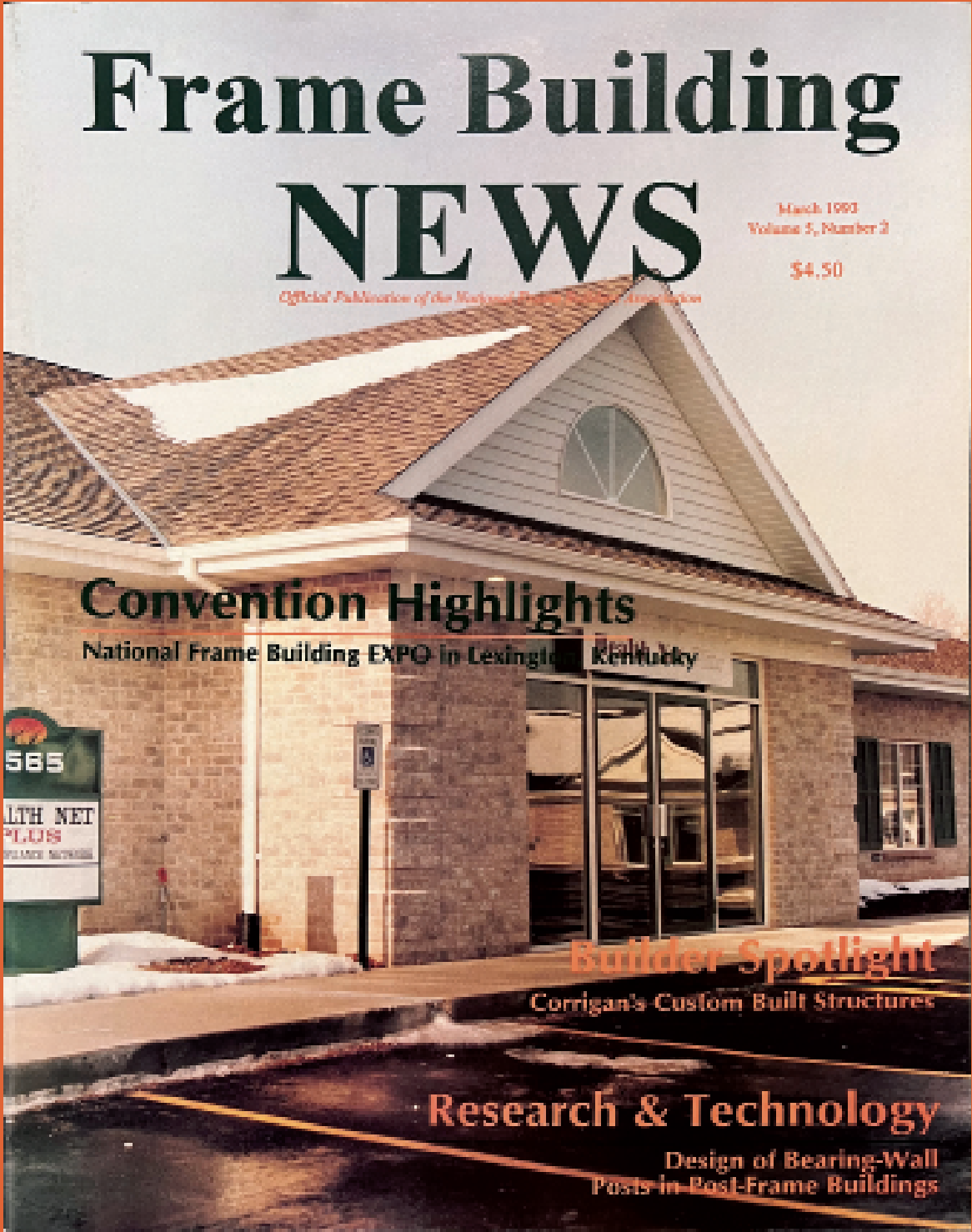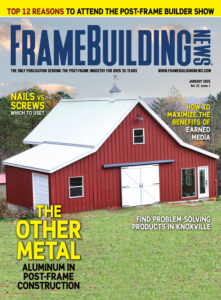By Richard F. Pritchard
In my March Frame Building Professional article I described a number of things you can do to decrease expenses and increase your profit and cash flow. To obtain additional ideas that frame builders can use, I recently spoke with Kenneth Kistler, president of Kistler Pole Building Co., Fogelsville, Pennsylvania, and a director of the National Frame Builders Association.
Ken has been in the post frame construction business for twenty years and he and his wife, Beverly, founded their own company in 1981. During the summer of 1989, his company peaked in size with over 70 full-time, non-unionized employees. Currently, they employ about 35 people representing construction, yard, and office functions. Ken felt signs of an eventual slowdown in his business starting as early as November, 1989.
Ken told me, “There is virtually no large frame construction in my area – only very infrequently, and then the competition is really stiff. Most of our work now is small buildings, those ranging in price from about $10,000 to $20,000. Interestingly, our level of leads and inquiries has not gone down very much from last year but the gap has widened between inquiries and sales. There is interest in new construction, but a lot of potential customers are reviewing our quotes and then putting the building projects on hold. We give them estimates but they decide to wait.
“I don’t think price is the issue. Rather, I think many customers are afraid of the economic uncertainty, and particularly the uncertainty in the Mideast. Once things are stabilized in that area and we have a good idea of what fuel prices will be, I think our business will improve. The waiting is very difficult.”
Cutting Costs
When it comes to cost reduction, it is important to examine all of your costs – a little savings here and there can add up to a lot of money. This is the approach Ken Kistler has taken to reduce the costs in his business.
“Of course”, Ken remarks,..as business slackened we have had to lay off people in all areas of our business, including office personnel. This hasn’t been an easy process. It is tough as a business owner to let people go. We didn’t just reduce personnel; we did a lot of other things to reduce costs especially in the areas of inventory and insurance.”
Better Inventory Control Saves SS
Inventory control has become a very important item for Ken’s company. Inventory is expensive since it ties up precious dollars, occupies space, requires insurance, is subject to damage and pilferage, and may become obsolete. Ken told me that during the past 18 months he had reduced inventory by 50 percent. Now, he is at the “bare bones” inventory level – as low as he can operate.
Ken indicated that is business starts to pick up he will have to purchase more inventory immediately. If other contractors and business managers have tightened inventory to the extent that Ken has in his company, demand for materials will be very high when business starts to pick up again. This is likely to mean increases in material costs – increases that must be factored into estimates to maintain profit margins.
As business slackened, Ken reviewed all his inventory to identify the “dead” items – those which were seldom used or damaged. He decided to sell all nonessential inventory, even at a loss, to generate cash. He identified the material for sale and advertised it Some purchasers were people who wanted to build their own structures. Others were contractors whose purchases even included dented items. Evidently, some customers will even accept dented structures if the price is right.
At the same time, Ken tightened his recycling policy to be sure that all scrap steel and aluminum was saved for sale rather than just thrown away. Ken told me, “Having a recycling policy helps employees to understand how tight money really is. We don’t want to throw anything away that can be sold as scrap.”
Examine Insurance Costs
Workman’s compensation insurance costs are a major expense for all frame builders. In Pennsylvania, where Ken has his business, the rate for workman’s compensation insurance is $14 per $100 of gross salary for construction employees. Premiums are based on employer’s ual estimates of the volume of business for the year. Therefore, as Ken notes, “When volume is not as high as anticipated, it is important to go back and review your policies, indicate the actual volume, and apply for premium reductions.”
In addition to workman’s compensation insurance, Ken comments that this is the time to examine all insurance policies. He increased his comprehensive and collision deductibles and dropped these coverages on some equipment that had seen heavy use. He told me that his decision to drop coverage depended primarily on equipment and vehicle condition rather than age.
Cutting Equipment Costs
Like many other contractors, Ken has invested rather heavily in equipment during the past few years. His big purchases included a new crane, tractor trailer, and a digging unit. Each of these was financed separate!y. Keri knew that he had to reduce his monthly payments since his cash inflow was down. He presented his bank with a plan that would reduce monthly payments by 50 percent. The plan called for one loan on all of his equipment and vehicles, with an extension of the financing period for about two years. Ken successfully negotiated the plan last December at a floating rate of one and one quarter percent over prime – a lower rate than he had been paying on the individual equipment loans. Ken does not envision purchasing any additional equipment for the next two or three years since some of his newer equipment is still not in heavy use. In fact, he is even holding off on the replacement of such minor office equipment as calculators when a backup is available. He will continue to rent specific equipment when needed – equipment such as man-lifting platfonns that are not used regularly.
Other Cost Saving Ideas
Ken has cut his monthly telephone costs in about half, saving about $500 to $600 per month. The savings was achieved by changing plans for his mobile telephones and for his “800” number. Ken notes,” Our cellular phone and long distance plans were based on a high volume of calls. With business off, our usage has decreased. So, I checked and found that if we changed plans we could decrease our charges. Savings of this magnitude are a real help.”
In addition to negotiating a new loan for his equipment and vehicles, Ken is working with his bank to obtain an increase in his line of credit. He knows that it is far better to negotiate for a loan in advance – when you don’t need the money – than to wait until you do. Banks like a lot of advance notice, and especially in this period of failing banks and cautious bankers.
As a part of his loan application, Ken had to have all of his properties reevaluated even though he had an evaluation about two and one half years ago. The change in real estate values necessitated it. He expected values to be less, and they were; however, the changes weren’t as great as expected. Ken feels the prices would have decreased more in his area if real estate sales had been greater, but now everyone seems to be just holding on and waiting rather than listing property and selling it at low prices.
Ken is starting to look at the cost of employee benefits. Although his company does not have a pension or profit sharing program, the company does pay for employee health insurance. Now that Ken’s carrier notified him of a 20 percent rate increase – a large increase in slow times – he may be forced to ask employees to pay for a part of the premium.
Closing Thought
Ken concludes, “Trimming overhead and watching all costs very carefully has given us flexibility to be competitive. We know our break even point at varying levels of volume and that really helps when it comes to bidding on larger jobs. I am not sure that other contractors know their break even points. Consequently, they may be underbidding jobs and this causes a problem for all of us. I think it is very important that all contractors study their costs very carefully and develop quotes that will assure a profit.”
Publisher’s Response
The Publisher’s letters for June/July Roll forming and July Rural Builder were written based on the possibility that we are entering a recession. In April 1991 Frame Building News, Robert F Pritchard Ed.D. wrote an excellent article titled, “Strategy for Success During a Recession.”
The Q1 GDP came in at -1.4% when everyone assumed it would be positive and recovering after the pandemic. The last negative GDP reports were when the pandemic started (when everything shut down) and before that in 2008.
A recession is defined by the Oxford Dictionary as “a period of temporary economic decline during which trade and industrial activity are reduced, generally identified by a fall in GDP in two successive quarters.” With one quarter on the books, we may very well be entering a recession. Historically, recessions seem to last about two years.
The Producer Price Index is at approximately 8%, the highest since about 1980. So, the cost to manufacturing is up. The Consumer Price Index is about the same and the highest since 1982.
Either because of this, Fed monetary policy or both, several major financial institutions (including Deutsche Bank) are predicting a major recession. The more optimistic financial institutions are predicting only a minor recession.
I do not dispute what Dr. Pritchard wrote in 1991. His article provides valid suggestions that remain applicable after 30 years. But, I would like to provide a different perspective.
As a disclaimer, I have very little formal education in finance. Micro and Macro in college is the extent of my financial academic pursuit.
You may know, I personally went from being a Publisher to owning the business almost exactly three years ago (July 2, 2019). I had a conversation with a friend who owns another business a few months ago. He said (paraphrased, because I am old and forget things) that you are new to this and still in a growth phase. There is a point where you will decide protecting what you have is more important than growth.
Businesses have life cycles. They roughly follow a bell-shaped curve regarding growth. Accountants are not expert at creating growth. Their expertise is typically managing status quo or decline. They become involved after the growth phase and are tasked with managing success, not creating it.
There are two sides to any ledger, credits and debits. What distresses me is when accountants, bankers or financial academics address preparing for a recession or adapting to a decrease in revenue, they address the debit (expense) side of the ledger almost exclusively. They are paid and trained to be risk averse and conserve wealth above all else. Their responsibility is to count and protect their client’s money. They typically were not integral to the decisions that initially generated the money.
Entrepreneurs, marketing or sales people look at the credit (revenue) side of the ledger when solving challenges.
One of my favorite quotes is “Our company had a meeting to discuss the recession, and we voted not to have one! The recession is in here,” pointing to his head. “Not out there.” – Zig Ziglar.
Yes, you can absolutely manage a recession by controlling the debit side of a ledger. I prefer to attempt to manage the revenue side.
To that end here are a few suggestions:
Are you fully utilizing your resources?
One of the most often overlooked resources is your database of customers. If you provided good services or products, it is easy for existing customers to make another buying decision from a trusted partner.
What else are you equipped to produce that these happy customers would buy?
If you do post frame construction, can you take the half step toward decks, portable sheds or other products? If you have done business with them already they have the financial strength for a smaller product and pre-qualified prospects.
Can you take market share from your competitors?
One of the first investments accountants drop in a difficult economy is marketing. If your competitors stop advertising, that may be the best time for you to start or increase. If customers cannot find you they cannot buy from you.
What services can you add?
Often, how you are perceived in the market allows you to gain market share. If you are adding services when others are struggling, the obvious impression is that your business is superior. One wonderful service to add is financing capability. In addition to appearance, you are solving a challenge for the customer and making it easier for them to say yes.
I do not advocate ignoring the debit side of the ledger; I am saying look at both. Everything is based on risk and reward. Focusing exclusively on the risk (debit/expense) side is not the answer.
In an attempt to compensate for my lack of formal economic education here is one final quote.
“In the midst of chaos, there is also opportunity” – Sun Tzu, The Art of War
Gary Reichert
Publisher
FBN























